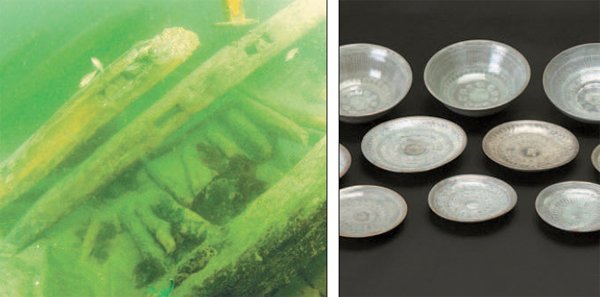First shipwreck from Joseon Dynasty is found

Left: Korean researchers said on Wednesday the ship they found in waters off Mado Island in South Chungcheong last year is from the Joseon Dynasty (1392-1910). Right: The key to dating the ship came from 140 pieces of Buncheong ceramics found on the ship. Provided by the Cultural Heritage Administration
Although Joseon was the country’s most recent kingdom, and the sea has always been an important transportation route for the country, Korea has never found a shipwreck from the entire span of the dynasty.
Koreans have discovered 12 ancient sunken ships so far, 11 from the Goryeo Dynasty (918-1392) and one from the Unified Silla Period (676-935).
Researchers from the National Research Institute of Maritime Cultural Heritage said Wednesday that a ship they found in waters off Mado Island in South Chungcheong last year was indeed from the Joseon era.
The key to dating the ship came from 140 pieces of Buncheong ceramics found on the ship during underwater excavation.
Buncheong ware was produced during the first 200 years of the Joseon Dynasty and embodies the transition from Goryeo celadon to Joseon porcelain.
Based on the 140 pieces of Buncheong ceramics, researchers are certain that the ship sank between 1400 and the 1420s.
Some of the ceramics are engraved with the abbreviation “Naeseom,” which refers to Naeseomsi, a government organization that oversaw items used within the royal court.
According to Park Kyung-ja, an expert in ceramics, Naeseomsi was likely set up in 1403.
The government mandated that items being shipped to the royal court be engraved with the mark of the royal organization in 1407.
“The techniques and patterns of the ceramics,” Park said, “also match those of the ceramics made between the late Goryeo period and the 1420s.”
Another intriguing find in the ship are the mokgan, or wood sticks on which people left writings. About 60 sticks were found inside the wreck.
“Many wood sticks have been found in shipwrecks in the past, but these are the first from the 15th century in all of East Asia,” said Lim Kyoung-hee, a curator at the research institute’s underwater excavation and conservation division.
She noted that the sticks specifically mention that the ship departed from Naju, South Jeolla, and was headed to Gwangheungchang [in today’s Mapo District in Seoul], a royal organization that oversaw taxes.
This is rare, according to Lim, because the wood sticks found in other shipwrecks rarely stated the points of departure and destination so clearly.
Researchers believe the Joseon ship was carrying Buncheong ceramics to the royal court and that they were a form of tax payment for a certain region.
“Shipwrecks are like time capsules,” Rha Sun-hwa, head of the Cultural Heritage Administration, said.
“The Korean Peninsula is mostly surrounded by sea, and we know sea routes were important. But it’s discoveries like this that help us learn more.”
BY KIM HYUNG-EUN [hkim@joongang.co.kr]










with the Korea JoongAng Daily
To write comments, please log in to one of the accounts.
Standards Board Policy (0/250자)